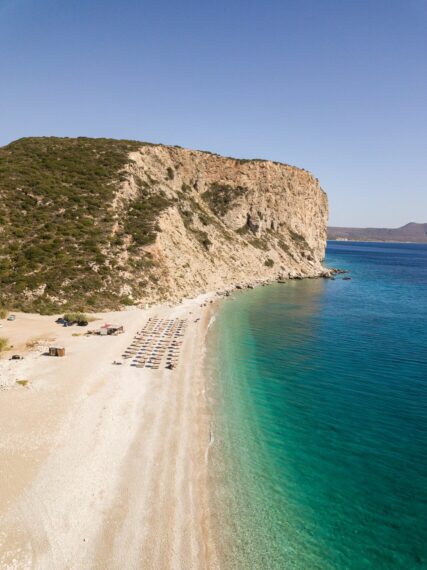Discover Kythira
What to do in Kythira
Waterfall of the Fonissa or of the Neraida
After parking your car in Mylopotamos, you will get the path that for years led to the, now wrecked, watermills. Along it, you will see several stone ruins of water mills that used to operate in the canyon and gave their name to the region Mylopotamos (mill-river). As you proceed, you will begin to hear the sound of the waterfalls below, while you will be welcomed by the countless colorful ‘liveloules’-dragonflies, which are the main residents this fairy land. At the first waterfall, the water emerges from 20 meters high, forming a pond where you can cool off and enjoy the lush landscape. Just below, the magical scenery is complemented by another waterfall that forms another pond. A huge plane tree provides shade, and the play of the light through its branches onto the landscape adds to this magical atmosphere. Be advised: the waters of the two ponds are crystal clear and tempting, but the temperature is comparable to what you might find in Alaska, so don’t be a hero. The cool oasis is an ideal refuge from the strong midday sun of summer, and of course one of the must-see spots of the island. –
Copyright © wondergreece.gr
Kapsali and the twin bays
Though at its southernmost edge, Kapsali is the hub of the island. You’ll be captivated by this lively waterfront hamlet with its twin bays and solitary lighthouse. Bars, cafes and restaurants serving fresh fish and lobster, hotels, rooms to let, galleries and outdoor bookstalls on the coastal road all contribute to this bustling and accommodating atmosphere.
Paleohora: Mediaeval Kythira, city of ghosts
The castle-state of Agios Dimitrios, a place of legends and ghosts, used to be the island’s capital and is perhaps its most important historical site. Built by people from Monemvasia in the 12th century above two canyons at an altitude of 216m, it is not visible from the sea. Despite this, the infamous Ottoman admiral and former corsair Haireddin Barbarossa discovered, besieged and destroyed it. Exploring the ruins of its 80 houses and 20 churches is a haunting experience. The sole intact church of Agia Varvara is an architectural masterpiece.
Hytra: A dazzling experience
At a particular hour of the day the sun shines into the cave of the islet of Hytra, turning the waters turquoise and the walls golden. You can get there by boat from Kapsali and swim inside the cave. At 200m long and 22m high, it is one of the most spectacular in Greece.
Agia Sophia: The chapel in a cave
Life-size frescoes of saints painted in the 13th century greet you at the entrance of one of the most spectacular sights in Kythira. Inside the stalagmites and stalactites are natural wonders.
source: discovergreece.com
